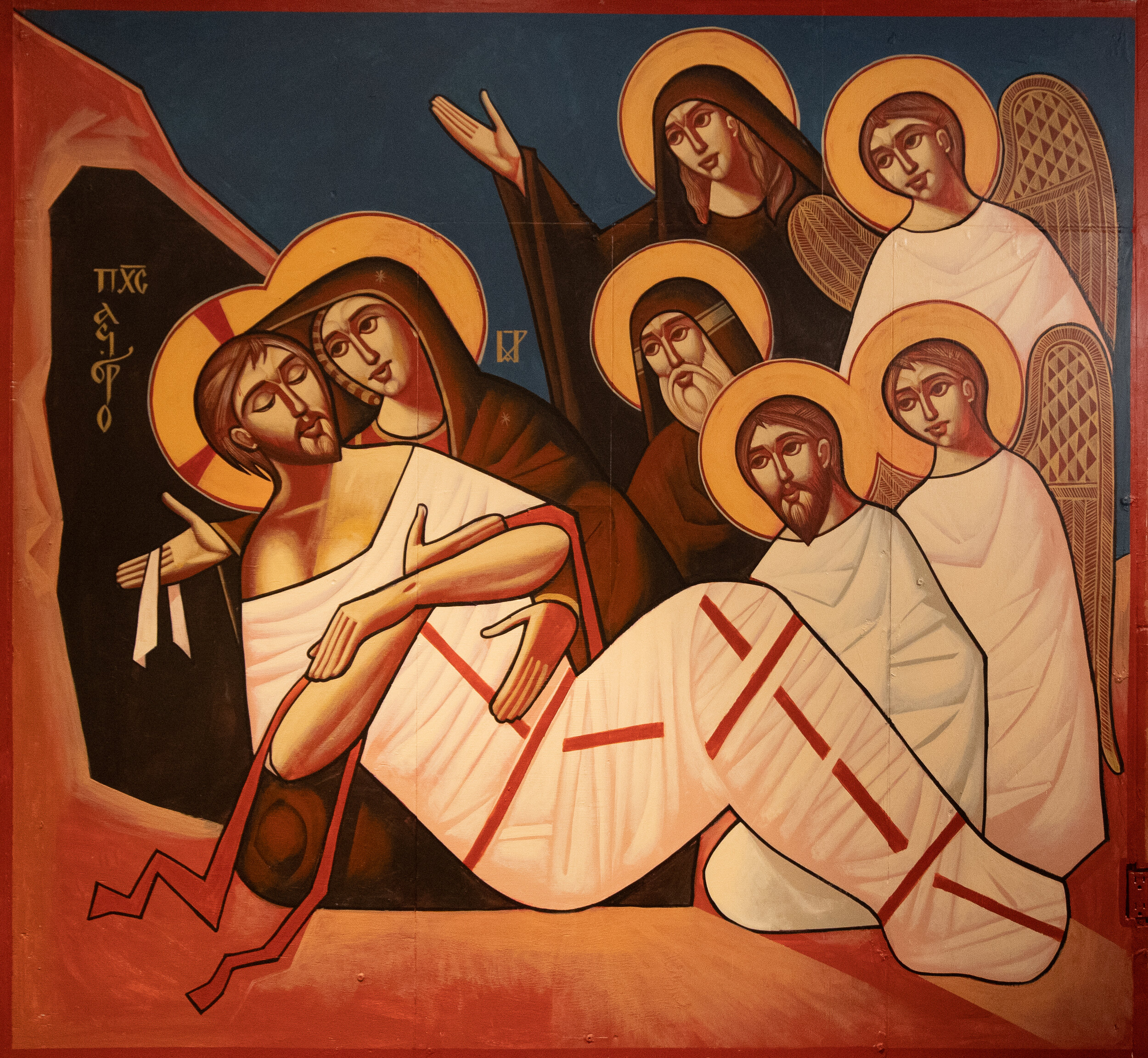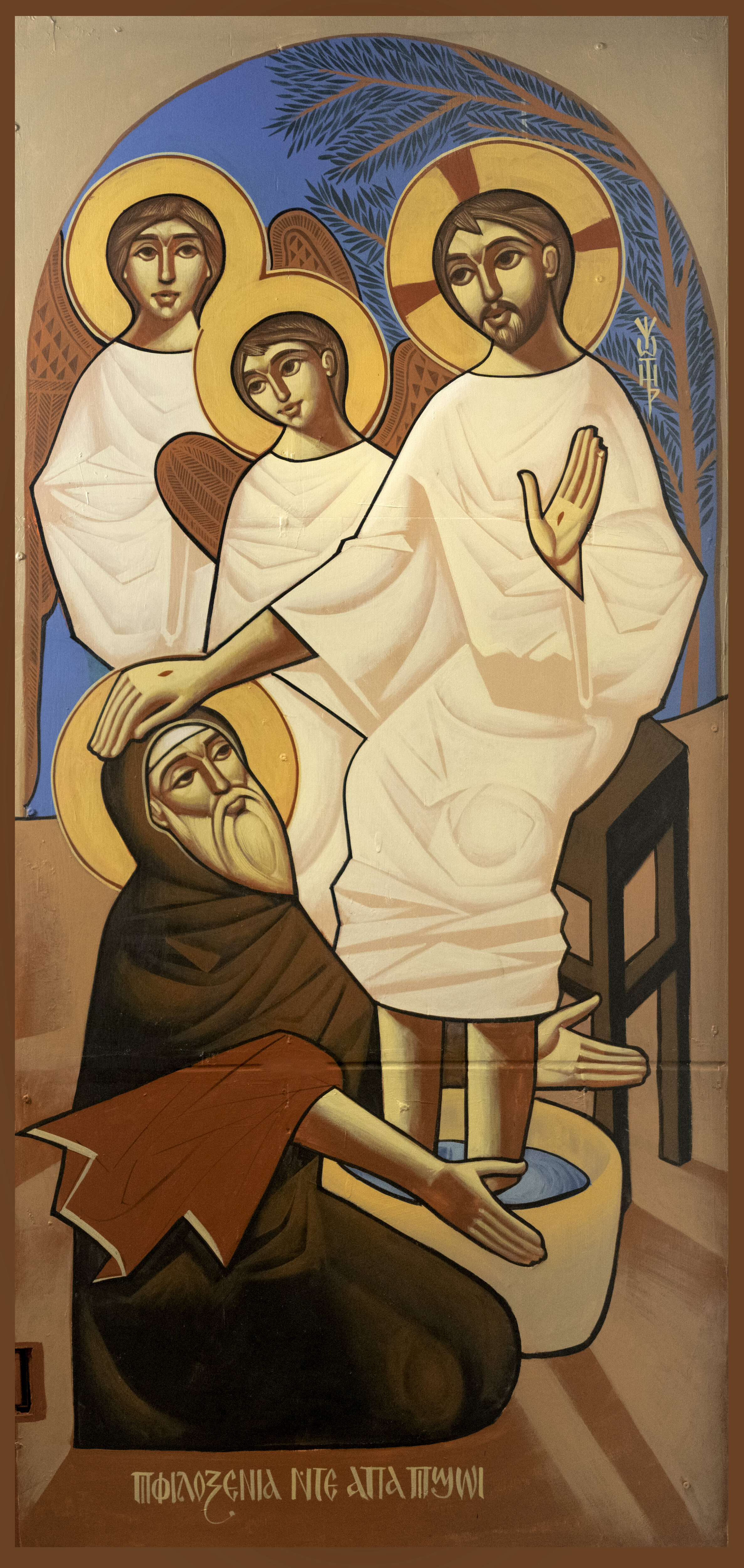THE CHAPEL OF HOSPITALITY
Located on a private residence, this chapel consists of a painting program that pertains to the concept of hospitality, welcoming Christ into the home, and being that home itself. The chapel thus contains saints and Biblical scenes in which Christ is welcomed in a personal experience.
introduction
The iconographer orchestrates a symphony of colour, symbolism, and theology that is designed to harmonize with the liturgical practices that take place in the space. The chapel is the culmination of the work of the Holy Spirit in an icon. It is through the Holy Spirit that the entire space is transformed, not just the eucharistic elements. The space becomes the uniting place of Heaven and earth, a symbol of the Virgin, and the ground on which the prophet removes his sandals. Thus it is crucial for the space to be designed with reverence to tradition and scripture, not produced with whims or preferences, but as a conduit for the breath of God Himself. The church has arranged for us a system in which the icons bring forth the chorus of the heavenly into the dynamic appeal of humanity to the throne of God, and thus the icons and liturgical art form the spine with which this system functions.


the eastern wall
The Eastern wall consists of the Virgin enthroned (acting as the ultimate dwelling place for Christ as “sojourner” in the theme of Hospitality), flanked by Archangels Michael (Left) and Gabriel (Right). She presents Christ to the viewer with her right hand, and in her left hand she holds a small maniple, symbolic of the Eucharistic aspect of the Lamb she carries on her knees. The carpet underneath her contains a bush with suggestions of red, an allusion to the burning bush that symbolizes her.
The four prophets on the upper register of the east wall are as follows from left to right: Solomon, David, Moses, and Isaiah. They all present both the star of the east above the Virgin and the Virgin and Child herself to the viewer in an act of prophecy of the incarnation, inspired by the composition on the Western semi-dome of the monastery of the Syrians. The text on David’s scroll reads Psalm 132:13 “For the Lord has chosen Zion; He has desired it for His dwelling place” (ϫⲉ ⲁⲡϭⲟⲓⲥ ⲥⲱⲧⲡ ⲛⲥⲓⲱⲛ ⲁϥⲥⲱⲧⲡ ⲙⲙⲟⲥ ⲉⲩⲙⲁⲛϣⲱⲡⲓ ⲛⲁϥ ⲫⲁⲓ ⲡⲉ ⲡⲁⲙⲁⲛⲉⲙⲧⲟⲛ ϣⲁ ⲉⲛⲉϩ ⲛⲧⲉ ⲡⲓⲉⲛⲉϩ ⲁⲓⲛⲁϣⲱⲡⲓ ⲙⲡⲁⲓⲙⲁ ϫⲉ ⲁⲓⲟⲩⲁϣϥ) and Isaiah’s scroll reads Isaiah 7:14, “Behold, the virgin shall conceive and bear a Son, and shall call His name Immanuel” (ⲉⲑⲃⲉ ⲫⲁⲓ ⲛⲑⲟϥ ⲡϭⲟⲓⲥ ⲉϥⲉϯ ⲛⲱⲧⲉⲛ ⲛⲟⲩⲙⲏⲓⲛⲓ ϩⲏⲡⲡⲉ ⲓⲥ ϯⲡⲁⲣⲑⲉⲛⲟⲥ ⲉⲥⲉⲉⲣⲃⲟⲕⲓ ⲟⲩⲟϩ ⲉⲥⲉⲙⲓⲥⲓ ⲛⲟⲩϣⲏⲣⲓ ⲉⲩⲉⲙⲟⲩϯ ⲉⲡⲉϥⲣⲁⲛ ϫⲉ ⲉⲙⲙⲁⲛⲟⲩⲏⲗ).
On the other side of the star is John the Baptist, presenting a disc with a lamb in allusion to John 1:29. John completes the register of prophets on the left of the star, but is also directly above St Moses and across from St Pishoy, so as to suggest his role as an ascetic.
the western wall
In conjugation to the theme of hospitality, the Western wall is dedicated to the Hospitality of Abraham, with Christ (appearing as an Angel, the pre-incarnate Logos) flanked by two angels, approached by Abraham and Sara. The hem of Sara’s garment reads, “And Sara said, “God has made me laugh, and all who hear will laugh with me.“ (ⲡⲉϫⲉ ⲥⲁⲣⲣⲁ ⲇⲉ ϫⲉ ⲟⲩⲥⲱⲃⲓ ⲁϥⲁⲓϥ ⲛⲏⲓ ⲛϫⲉ ⲫⲛⲟⲩϯ ⲫⲏ ⲅⲁⲣ ⲉⲑⲛⲁⲥⲱⲧⲉⲙ ϥⲛⲁⲣⲁϣⲓ ⲛⲉⲙⲏⲓ). The three sit around the table, inviting the viewer to join them in the empty space. The hem of the tablecloth reads John 14:23, “If anyone loves Me, he will keep My word; and My Father will love him, and We will come to him and make Our dwelling with him.”
the southern wall
On the left of the South wall is St Moses the Strong. The patron saint of the family the chapel was painted for, the ascetic was also described as being hospitable in the Sayings of the Desert Fathers and the Paradise of the Fathers. Dressed in priestly vestments, the composition mirrors his depiction in the Red Sea monastery of St Antony. To the right of St Moses is Christ and Zaccheus. Zaccheus was hospitable to Christ who told him, “Zacchaeus, make haste and come down, for today I must stay at your house.” after which “he made haste and came down, and received Him joyfully.” The sycamore tree Zaccheus climbs is a common motif in Coptic art, and appears several times throughout the chapel. It is a Pharaonic symbol of paradise, and was often associated with the goddess Isis (and came to represent the Virgin Mary), this “paradise” of Christ represented by the sycamore trees further reinforces the concept of hospitality, the creation of a dwelling for Christ both in the home and in the soul.
To the right of the door is Christ and the sinful woman, who also received Him joyfully. The sinful woman anointing Christ parallels the burial of Christ on the Northern wall, as well as Sts Pishoy, also sitting at the feet of Christ. The “hospitality” of the sinful woman is highlighted by Christ when He says to Simon, “Do you see this woman? I entered your house; you gave Me no water for My feet, but she has washed My feet with her tears and wiped them with the hair of her head. You gave Me no kiss, but this woman has not ceased to kiss My feet since the time I came in. You did not anoint My head with oil, but this woman has anointed My feet with fragrant oil. Therefore I say to you, her sins, which are many, are forgiven, for she loved much. But to whom little is forgiven, the same loves little.” (Luke 7:44-47) Thus receiving Christ is not limited to physical hospitality, but expands to accepting Christ on a personal level, uniting with Him and becoming a “Christ-bearer.”
The ledge contains a text that wraps around the entire span of the room, reading the fifth part of the Wednesday Theotokia, ““Hail to the paradise of the word of Christ, who became the second Adam, for the sake of Adam the first man. Hail to the uniting place, of the unparted natures, that came together in one place, without ever mingling. Hail to the bridal chamber, decorated in every way, for the true Bridegroom, who united with humanity.” (ⲭⲉⲣⲉ ⲡⲓⲡⲁⲣⲁⲇⲓⲥⲟⲥ: `ⲛⲗⲟⲅⲓⲕⲟⲛ `ⲛⲧⲉ Ⲡⲓ`ⲭⲣⲓⲥⲧⲟⲥ: ⲫⲏ`ⲉⲧⲁϥϣⲱⲡⲓ `ⲙⲙⲁϩ`ⲥⲛⲁⲩ `ⲛ`Ⲁⲇⲁⲙ: ⲉⲑⲃⲉ `Ⲁⲇⲁⲙ ⲡⲓϣⲟⲣⲡ `ⲛⲣⲱⲙⲓ. ⲭⲉⲣⲉ ⲡⲓⲉⲣⲅⲁⲥⲧⲩⲣⲓⲟⲛ: `ⲛⲧⲉ ϯⲙⲉⲧⲟⲩⲁⲓ `ⲛⲁⲧϥⲱⲣϫ: `ⲛⲧⲉ ⲛⲓϥⲩⲥⲓⲥ ⲉⲧⲁⲩ`ⲓ ⲉⲩⲙⲁ ⲁⲩⲥⲟⲡ: ϧⲉⲛ ⲟⲩⲙⲉⲧⲁⲧⲙⲟⲩϫⲧ. ⲭⲉⲣⲉ ⲡⲓⲙⲁ `ⲛϣⲉⲗⲉⲧ: ⲉⲧⲥⲉⲗⲥⲱⲗ ϧⲉⲛ ⲟⲩⲑⲟ `ⲛⲣⲏϯ: `ⲛⲧⲉ Ⲡⲓⲛⲩⲙϥⲓⲟⲥ ⲙⲙⲏⲓ: `ⲉⲧⲁϥϣⲱⲧⲡ `ⲉϯⲙⲉⲧⲣⲱⲙⲓ.)” The uniting place references the incarnation presented on the eastern wall, while the bridal chamber “decorated in every way” refers both to the church and to the Virgin, the resting place of Christ, opened to Him by the worshipper in an act of hospitality.
the northern wall
Mark being welcomed by Anianos was included as a parallel to the Church welcoming Christ. St Mark raises one finger, didactically teaching Anianos about the “one true God” that he cried to. You can read more about this here.
The burial of Christ depicts Joseph of Arimathea, Nicodemus, Mary Magdalene, the Virgin Mary, and angels gathering around, stunned by the sight of the dead Christ. The presence of the angels alludes to a line from Tennav, sung during midnight praises during the Holy Fifty days: “The angelic hosts were amazed when they saw You counted among the dead, yet you destroyed the power of death, O Saviour.” The Virgin carrying Christ mirrors the Virgin enthroned on the eastern wall, with her bearing the same maniple in her hands and presenting the dead Christ to us as the eucharistic sacrifice, the Lamb slain for the salvation of all. Hospitality is shown by Joseph and Nicodemus in their provision of the empty tomb, which, at times, can be parallelled with our hearts. Christ, when welcomed into our “tombs” (hearts), slays death and frees us with His resurrection. Christ in this scene is wrapped in traditional Pharaonic mummy wrappings, as shown in this tomb painting.
St Pishoy here is depicted according to the account of St John the Short, who says, “One time, while the divine Pishoy was praying in his cell, Christ appeared to him with two angels, as He had appeared to the Patriarch Abraham, and said: "Hail, O Pishoy, today you must offer Us hospitality. " And Pishoy imitated the Patriarch accordingly. He welcomed them eagerly, but did not take care to prepare food or drink as did the Patriarch, but extended hospitality towards the Omnipresent One with a pure mind.” Thus the wings of the two angels are rendered in the same colours as those in the hospitality of Abraham, and the tree Christ rests under mirrors the oak of mamre, as the hospitality of St Pishoy proved the existence of a paradise of love in the middle of the desert.














